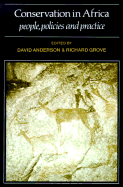Book contents
- Frontmatter
- Contents
- Preface
- List of contributors
- Introduction: The scramble for Eden: past, present and future in African conservation
- Part One Conservation ideologies in Africa
- Part Two Wildlife, Parks and Pastoralist
- Part Three Conservation priorities and rural communities
- Introduction
- 9 Local institutions, tenure and resource management in East Africa
- 10 Conflicting uses for forest resources in the Lower Tana River basin of Kenya
- 11 Environmental degradation, soil conservation and agricultural policies in Sierra Leone, 1895–1984
- 12 Managing the forest: the conservation history of Lembus, Kenya,1904–63
- Part Four Consequences for conservation and development
- Index
10 - Conflicting uses for forest resources in the Lower Tana River basin of Kenya
Published online by Cambridge University Press: 04 April 2011
- Frontmatter
- Contents
- Preface
- List of contributors
- Introduction: The scramble for Eden: past, present and future in African conservation
- Part One Conservation ideologies in Africa
- Part Two Wildlife, Parks and Pastoralist
- Part Three Conservation priorities and rural communities
- Introduction
- 9 Local institutions, tenure and resource management in East Africa
- 10 Conflicting uses for forest resources in the Lower Tana River basin of Kenya
- 11 Environmental degradation, soil conservation and agricultural policies in Sierra Leone, 1895–1984
- 12 Managing the forest: the conservation history of Lembus, Kenya,1904–63
- Part Four Consequences for conservation and development
- Index
Summary
Introduction
Forest resources are in increasing demand in most developing countries. About 90 per cent of people in these countries depend on firewood as their chief source of energy (Eckholm, 1975). Africa has the largest per person per annum consumption of firewood with an average of 1.18m3 per person in the least developed countries (UN, 1981). In most of these countries the demand for fuelwood is outstripping local supplies and whilst studies on fuelwood use have been carried out in some places, very little is known about natural forest productivity, so that it is extremely difficult to put values on supply and demand ratios.
Concern over fuelwood supplies in Kenya was voiced in the late 1960s and the 1970s, especially over the impact of diminishing forest cover on soil erosion, and in 1975 the Kenyan Government banned charcoal exports. Subsequently the Ministry of Energy in conjunction with the Beijer Institute has been trying to assess demands and supply. A number of studies in Kenya provide information on levels and patterns of firewood use and some consider alternative energy supplies, e.g. Brokensha & Riley (1978), Hosier (1981), Kamweti (1981), Shakow, Weiner & O'Keefe (1981), Hughes (1982) and most recently Barnes, Ensminger & O'Keefe (1984). On average it has been found that 1.4-2.4 m3 per person per annum of wood is used, based on household surveys (Hosier, 1981).
- Type
- Chapter
- Information
- Conservation in AfricaPeoples, Policies and Practice, pp. 211 - 228Publisher: Cambridge University PressPrint publication year: 1988

